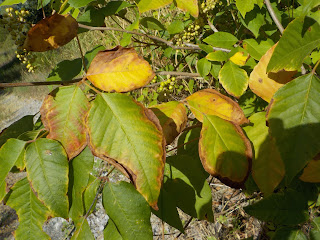I rarely ever see a snake in Oliver's Woods. This morning I encountered a slender garter snake, skimming away from me on the drying mud shore of the East Pond. It may have been attracted there by the scores of small young leopard frogs sitting on the soft damp soil, all that is left of the East Pond. The Northwest Pond is in a similar condition with a bit more soupy mud remaining in the center. The fish that were in the ponds (mosquito fish?) must have been scooped up by predators as they became stranded.
Oddly, the West Wash was still moderately well-filled with water flowing past Island Crossing at perhaps 2 gallons or 10 liters/ minute. The water in the wash was turbid and I am thinking it must be from a anthropogenic source. Maybe a burst water line? I should check this out.
I had gone to the Woods to see how the trees and other plants were responding to the heat and drought. Nothing catastrophic. The forest is under stress. Blackjack oak Quercus marilandica, Pecan Carya illinoinensis and red elm Ulmus rubra had some premature yellowing of (only some specific) leaves. Like a form of programmed self-pruning or programmed death of select units. The crowns remain green, not yellowing generally all over.
Taller mulberries and elms are now starting to drop a large number of leaves on the forest floor, enough to make the forest floor begin to look like early autumn east of East Pond. Happy to see this, as that means trees are forming natural abscission layers after setting buds for next years growth; rather than leaves simply dying and turning brown, hanging on dead branches.
In the under story, many/ most plants have wilted leaves. The leaves of the beautyberry shrubs Callicarpa are still a dry green, but they are shriveled and probably beyond resuscitation.
Trailside forbs, elephant's foot Elephantopus and lady's thumb Persicaria have drooping leaves but look they could return to life with a good rain.
There were two Three-Toed Box Turtles, probably, Terrapene carolina triunguis west of Island Crossing on the
trail. I did not disturb them. They reminded me to check on the upside down box turtle I righted - and hoped I had rescued a few weeks ago. I went to look for it, not there, so I am hopeful it survived.
Around the shore of the Northwest Pond fresh green pecan nuts were down, and some chewed open. Likely squirrels getting a jump start on autumn harvest. A few green walnuts had fallen but nothing feeding on them, the pungent smell of the green husk. On the same damp mud of the NW Pond a fresh Red-spotted purple butterfly and large yellow Tiger Swallowtail were 'puddling' taking up mineral nutrients, mostly sodium, dabbing their mouthparts on the soft mud.
There were two beautiful large Underwing noctuid moths that flew and landed on big bur oak and large pecan. Now late summer is good time to find these showy moths. As I was leaving, I looked at my jeans and noticed that the season of weed seeds is beginning. I snapped a few photos of the drying NW Pond to contrast with the days after first good autumn rains.
I imagine the snapping turtle that feeds there, has retreated under the shelf of roots on the south shore. Interesting to see the germinating seedlings on the drying East Pond bed. Wild grape, lady's thumb, other bits of green scrambling to start life on the bare wet soil. They will almost certainly be drowned when rains return but may have an ecological part to play before then.


.jpeg)








